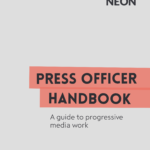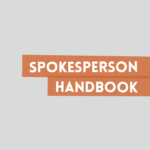Media Advisories
Media advisories inform the media about an upcoming event, whether it’s a march, a rally or a press briefing. Think of it as an invitation. Just like an invitation, the goal of an advisory is to grab the reader’s interest and make them want to come. What’s the hook that makes this the do-not-miss event? No need to get caught up in long descriptions; keep it to one page, this is more of a teaser. It is sent about a week before your event. Follow it up with a phone call to really sell your event a couple of days beforehand to be sure journalists have enough time to include it in their schedule.
It should include:
- Who is organising the event/activity, including what makes them interesting
- What the event or activity is, including your hook (for example: A nonviolent direct action! Street theatre! Students and elderly people riding bikes together! A study release!) If pitching to TV or radio, make sure to give a description of what might be interesting in terms of visuals or sounds.
- Where the event is (just the name and address is great)
- When it is (date and time)
- Why it’s newsworthy (re-state hook, why it matters, brief background and why this is happening now)
Press Releases
Press releases are what your ideal article for an event would look like. The goal is to give reporters all the information they would need to write a story, even if they didn’t show up. Aim to keep your press release to one page. Here’s a basic guide to how you can structure your press release:
- At the top include the date and a media contact’s information
- Headline: Include the most important/interesting news, in no more than 7 words. This is your chance to grab attention!
- Introductory paragraph: Short, with a hook. Should explain who did what, when, where, and why.
- Second paragraph: Provide more detail on the above. It should include a quote from your key spokesperson: pack in your most interesting information, the punchline, and your most compelling story (as concise as possible) to influence the feelings of readers.
- In the following paragraphs, present and explain the solution – i.e. why you are taking action, how we will solve the problem, and more forward looking information to give context of where this work/campaign is headed. Use additional quotes or paragraphs to reiterate the political context and your demand: What are you asking for? What is your goal?
- Traditionally press releases end with “###” (from the days of faxes) and after it you may want to append short paragraph (maximum 5 lines) about 350.org and your local climate group – i.e. who you are, and what you do. You can also include a NOTE TO EDITORS with additional background information in the form of links, or additional factual information that might not be of priority to include in the body of the text but would be of relevance to the journalists who decide to write a full story on the topic of the release.
- Whenever relevant provide a link to photos if you are sure to have high quality photos from the event/action.
Once it’s written, send the press release individually — or if not, at least make sure to use bcc! When sending out the press release to your contacts via email, the subject line is your headline. Copy and paste the rest of your release into the body of the email, and bring print copies to your event.
When to send
Here’s an ideal timeline for getting maximum coverage of your story. As you can see, it can be quite a bit of work. The most important thing is to get started early, designate a person on your team to be the main press contact, and follow the basic timeline below:
| Date | Action | Priority |
| 1-3 months before | Research journalists who are writing about events/stories related to your campaign. Build relationships with those journalists and bloggers | High |
| 1 month before | Get your event listed in community calendars on blogs, newspapers, radio shows, organisational websites, etc. | Low |
| ~10 days before | Start preparing press release, including getting permission for quotes and giving time for editing (and translation, if you need it) | High |
| 5 days before | Send media advisory by e-mail. Include a hook and info on interesting spokespeople/visuals, including contact information | High |
| 3 days before | Follow-up with a phone call to pitch the story and make sure they received the advisory | Medium |
| 1 day before | Re-send advisory. Follow-up by phone with confirmation calls to reporters. | High |
| Day of the action | Call reporters and confirm they are coming (call TV stations around 8am; print media around 10am) | High |
| Immediately after the action | Send out a press release that looks like the article you want written. May help others choose to cover it even if they weren’t there. Include link to photos where possible. | Medium |
| Day after | Read the press and follow-up with reporters on good/bad coverage | Medium |
Sample: Media Advisory Template
DATE
Contact: [Media contact from the team that will be available, with how to reach them by at least cell and email]
DYNAMIC TITLE WOWS REPORTERS
[concise, informative title, written in the style of a news headline]
EVENT TEASER — [2-3 sentence summary of the WHO, WHEN and WHAT of the event, with slight elaboration on the WHAT–make sure to contextualise the event with background information, and make it clear why the event is significant and newsworthy, but do not provide so much information that it becomes unnecessary to attend the event itself; on a similar note, do not include quotes. If your list includes TV or radio, give them a sense of how this event has great visuals or sounds.]
WHAT: Short one-phrase description of the event
WHEN: Date and time of the event, in the following format: Day of the Week, Month, Day, Time (specify time zone)
WHERE: Location of the event
WHO: Names/Groups (and titles, if applicable) of those carrying out the event followed by an explanation/description of those involved.
WHY: A couple of sentences explaining why this event is important and what is the overall context in which it is taking place highlighting local/regional issues of relevance currently at play.
[photos, visuals]
###
[The “###” is from the days these were sent by faxes to mark the end of your release. It’s still traditional, though some people put additional links or footnotes below it.]
Sample: Press Release Template
FOR IMMEDIATE RELEASE
DATE
CONTACT: [name], [role/organisation], [email address], [cell phone number]
TITLE [concise, informative title, written in the style of a news headline]
SUBTITLE (optional): brief description on what is different now–how whatever is in this release has changed things
EXPLANATION OF EVENT — These first 1-3 sentences should be a slightly more detailed explanation of what happened than your press release title. Here you can state the purpose of the action, and the outcome.
“[QUOTE] This quote should be from your key spokesperson (ex: student, administrator, or community member) who had a role in organising the event this press release speaks to, [include spokesperson full name and title]. This quote should give context on why this event/campaign is important and the main demand.
After the 3rd paragraph, things get a bit more freeform. Use a 4th or 5th paragraph to provide background on the campaign. Make sure to give enough info for journalists who may not have followed the campaign. You may give general background information. If it was a meeting or an event, explain who was involved, and what role they played.
“[QUOTE] This quote should be from another (if possible) organiser of your event or campaign lead.This quote should summarise the purpose, impact and importance this occurrence had with more forward looking information in terms of where this work is headed.
This final paragraph should speak to any next steps happening. It should explain how this action, event, meeting, etc changed the circumstance of your previous standing.
###
Notes to the writer:
- If you have additional quotes, photos, or information you would like to share with the press you can put it here.
- Don’t shy away from putting a personal touch to your release! Some of the strongest stories come from an individual perspective.
- Connect the dots –– explain how the contents of this release effect the larger movement.
See more examples: https://350.org/about/media/ or https://gofossilfree.org/media/

